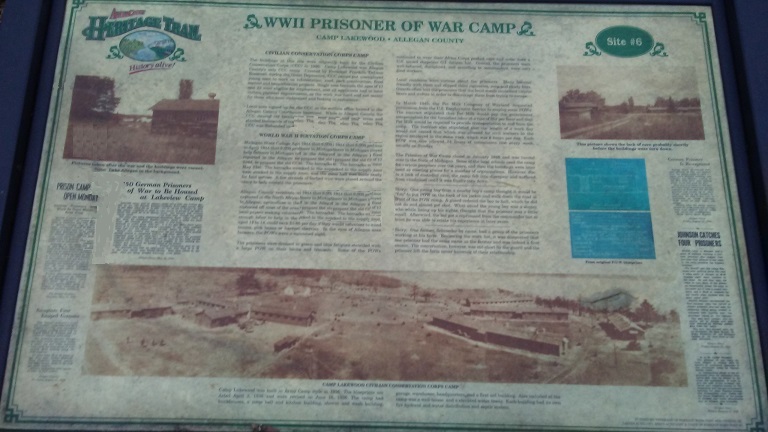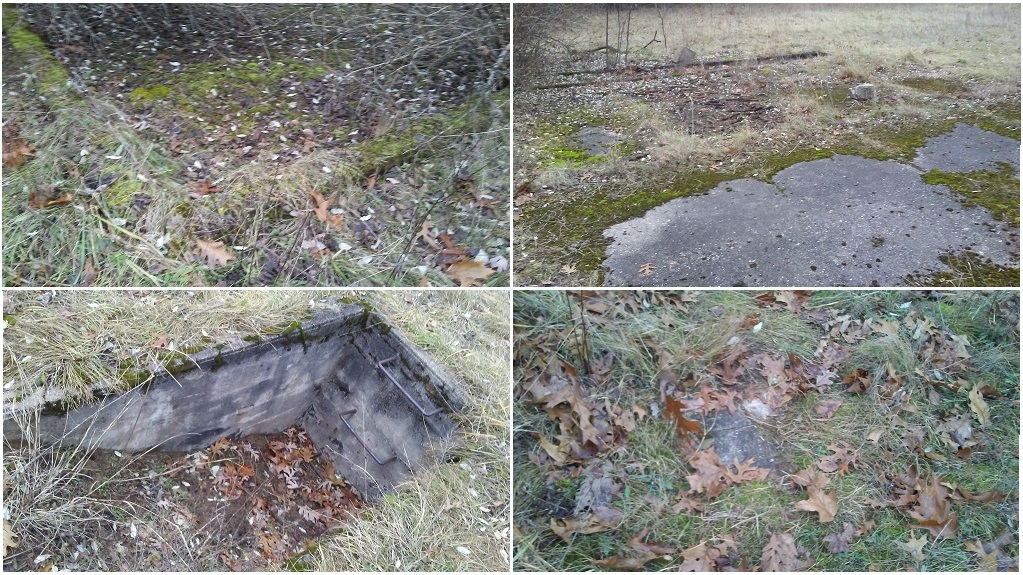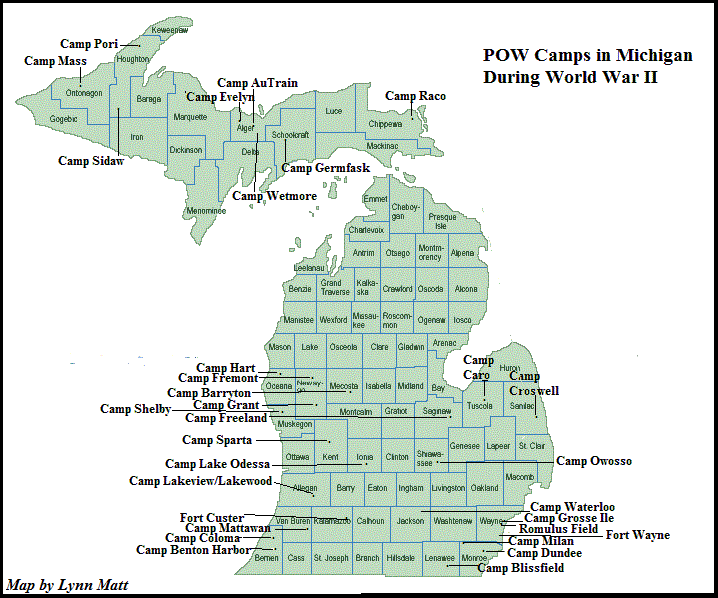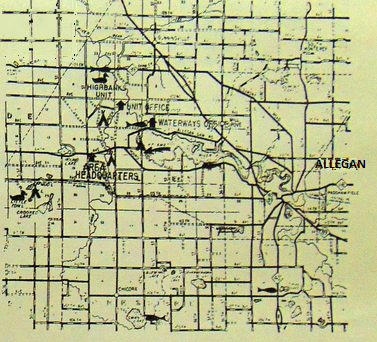 |
Camp Lakewood Lakeview Camp A WWII Prisoner of War Camp |
 |
 |
Camp Lakewood Lakeview Camp A WWII Prisoner of War Camp |
 |
 Heritage Trail Landmark Sign for Camp Lakeview/Lakewood |
 Left over Cement Foundation Slabs Is All That's Seen today |
 Michigan POW Camp Locations |
| |
PRISON CAMP OPEN MONDAY Work in Gunn Marsh Area First Prisoners at the camp are to be used first to the Gunn marsh muck area. When work eases there they may be used in other sections. Farmers needing as many as six or more men on a job and unable to find sufficient help are urged to sign labor contracts for the use of prisoners, but farmers are warned that all local labor available should be used before prisoners are requested. Further information concerning use of prisoners can be obtained from the Emergency Farm Labor office, phone 167 Allegan, or at the county agents office, phone 78 Allegan, or from members of the farm labor advisory committee. 250 German Prisoners of War to Be Housed at Lakeview Camp Lakeview camp, west of Allegan, will be the only German prisoner of war labor camp set up in Allegan county, according to word received this week by A.D. Morley, county agent. The camp was being conditioned this week for occupancy Sunday when 250 German prisoners are expected to arrive along with an escort of 73 United States army enlisted men and five officers. Barbed wire fencing was being erected around a compound that comprised most of the camp barracks and dining hall in which the prisoners will be housed. The army officers and men will be housed outside the compound. The prisoners will first be used in the Gun Marsh area, Morley said. They are being brought in under terms with the Federal Emergency Farm Labor agency. They will be let out to farmers in Allegan county in groups of six men or more. The farmers will contract for their labor through the county Emergency Farm Labor office. In Allegan, which is under to direction of Guy Teed. It is the plan of the Farm Labor committee to use every available worker before the prisoners are sent out and farmers were warned to seek other labor first. Later in the season, the prisoners will be used in the fruit harvest and possibly in the canning factories in the county. Further information may be obtained from Guy Tween or A.W. Morley. Both have offices in the county court house. ---------------------- Curved arrow below, points to location of the former Allegan Prisoner of War Labor Camp. 
For some, an end; for others, a beginning of War to Be Housed at Lakeview Camp Down at Fort Custer National Cemetery, a few miles west of Battle Creek, 26 white marble headstones are among the few reminders that German soldiers ever were held prisoner here. Most of the stones, with names like Paul Beiersdoerfer, Kurt Behring, and Karl Arzberger, bear the same date: Oct. 31, 1945. That's the day 16 POWs and their U.S. Army guard were fatally injured when a truck carrying them back from a beet farm to their camp near Blissfield was struck by a train. "A New York Central passenger train demolished the truck, striking it broadside and strewing bodies of victims and wreckage 300 feet along the right-of-way," a story in the next day's Grand Rapids Press reported. A mass funeral service was held at Fort Custer three days later, and the men were buried in the cemetery where some 8,000 American veterans rest. The other 10 German soldiers buried there died of natural causes during their imprisonment. The graves are maintained by the U.S. government. Members of the German-American community donated a marker, and on the third Sunday every November, the German Day of National Mourning, they gather there to pay tribute. A few miles away at Fort Custer, there is no sign that 5,000 POWs were once held there. The site of the POW camp is now an industrial park. Many of the companies there are German owned. As a child, Michigan National Guard Sgt. Richard Larson, 58, used to hang around the fort, where he now is stationed. He remembers when he first saw the German prisoners. "Oh yeah, they were all over the post," he said. "They wore blue uniforms with 'PW' on the back. I asked a guy, 'Who are those guys,' and he said, 'They're German prisoners.' Scared the crap out of me." But many of the prisoners, far from dangerous, were glad to be free from their Nazi commanders. Ernst Floeter, a German private, refers to the day head was captured at Normandy as "when I was liberated." From the day he was forced into service, he had hoped he would be captured by the Americans. He was among several Germans surrounded by American soldiers 12 days after D-Day. "I threw my rifle down, happy that my wish had come true," said Floeter, 69. "I was very happy about it. My first thought was, 'Thank heaven.' "It was a beautiful affair, very nice and very humane and strictly according to the Geneva Convention." He was shipped to Ellis Island and briefly held at Fort Custer. "The treatment was fantastic, and the food was great," he said. "We had more freedom as prisoners of war than we did as German soldiers. For me it was paradise on earth, coming from the conditions of the German army." Like many former POWs, after the war, he and his family emigrated to the United States. They became American citizens in 1962 and settled in Grand Ledge, where he owns a photo studio. "We never regretted our decision coming to this country one-tenth of a second." Floeter said. "We are happy, because we are Americans." Ernst Werner Floeter is buried in the Immanuel Lutheran Church Memorial Garden of Grand Ledge, Michigan. |
Some of the buildings for Michigan POW camps were originally built for the Civillian Conservation Corps (CCC) in 1936. CCC camps were created by President Franklin DeLano Roosevelt during the Great Depression , CCC camps put unemployed young men to work on reforestation, road, park construction, flood control and beautification projects. Single men between the ages of 17 and 23 were eligible for employment, and all applicants had to meet certain physical requirements, as the work was hard and not meant for those who were undersized and lacking in endurance. The Allegan Gazette has an article in the March 30, 1939 edition that indicates the Michigan Odd Fellow organization had an interest in taking over the government camp on Lake Allegan and use it as a center for an under-privileged children's program. Odd Fellow and Rebekah groups and children who who received benefits at the camp would come from all parts of Michigan. Estimation that 200 boys and girls could be handled at any one time through facilities of the camp. There is no information stating that this lease agreement took place. There is, however, an Odd Fellow and Rebekah Camp in Baldwin, Lake County, Michigan east of Ludington. There was no POW camp located there.
Michigan State College Agricultural Extension Service released news in April 1944 that 5,000 prisoners of war (POW's would be assigned to help farmers in Michigan harvest their crops.) The Federal Emergency Farm Labor office reported in the Allegan newspaper that POW's would start at $8 a day in 1944, to prepare the old CCC camp for 250 prisoners, set to arrive on May 21st. The barracks were cleaned and aired, Army-issued rations were stocked in the supply room, and the mess hal was made ready for food service. A few strands of barbed wire were placed around the camp to help contain the prisoners. Allegan County residents welcomed the German POWs who were captured in the North African Campaign. Prior to these POWs coming to Allegan, agriculture in the community suffered because draft calls siphoned off most of the area's able-bodied men. Full page ads in the local papers seeking volunteers to work in the fields couldn't generate enough labor to help in the farms and orchards. Even younsters, aged 11 to 14, could earn $3.65 per day if they would volunteer to weed onions, pick beans or harvest cherries. In the eyes of Allegan area farmers, the POWs were a welcomed sight. The prisoners were dressed in green and blue fatigues stenciled with a large POW on their backs and trousers. Some of the POWs continued to wear their Africa Corps peaked caps and some wore a U.S. issued shapeless G.I fatigue hat. Overall, the prisoners were very good workers. Local residents were curious about the prisoners. Many became friendly with them and slipped them cigarettes, soap and candy bars. Guards often told the prisoners that the local woods contained vicious bears and wolves in order to discourage them from trying to escape. In March 1945, the Pet Milk company of Wayland requested permission from the U.S. employment service to employ some POWs. The contract stipulated that Pet Milk would pay the government for the furnished labor at a rate of 65¢ per hour and that Pet Milk would be required to provide transportation to and from the camp. The contract also stipulated that the length of a work day would not exceed that which was allowed for civil workers in the region employed in the same work, which was 8 hours per day. Each POW was also allowed 24 hours of consecutive rest every week, usually on Sunday.
The Prisoner of War camp closed in January 1946 and was turned over to the State of Michigan. Some of the local schools used the camp for various purposes over the years, and the buildings were later used as meeting places for a number of organizations. However, due to a lack of custodial care, the camp fell into disrepair and suffered from vandalism until it was finally torn down ---------------------- Story: One young boy from a nearby boy's camp thought it would be "fun" to put POW on the back of his jacket and walk down the road in front of the POW camp. A guard ordered the boy to halt which he did not do and almost got shot. What saved the young boy was a sentry, who while lining up his sights, thought that the prisoner was a little small. Afterward, the lad got a reprimand from the commander but at least he was able to relate his experience in later years.---------------------- Story: One farmer, Schroeder by name, had a group of the prisoners working at his farm. Reviewing the work list, it was discovered that one prisoner had the same name as the farmer and was indeed a first cousin. The conversation, however, was cut short by the guard and the prisoner left the farm never knowing of their relationship. |
FOUR PRISONERS Sheriff Louis A. Johnson and a posse of deputies captured 4 German prisoners who escaped from the Lake View prisoner of war camp in the early morning fog Tuesday morning. The Sheriff said, the young Germans were walking along the road 6 miles south of Allegan on M-40 Tuesday night when accosted by the posse. He said that upon his order to halt, three of the prisoners immediately raised the arms in surrender, but it took a second command and a show of weapons for the fourth come foward with his arms raised aloft. Sheriff Johnson apprehended the four escapees upon the tip-off of Grover Anderson who had seen the suspicious looking group dressed in raincoats with bundles over the shoulders hiking on the highway. The men were brought into county jail in Allegan and were later removed by Military authorities from the camp. The men who escaped were: Arthur Kaufmehl, 23; Egon Burger, 22; Heinz Fluechter, 19; and Hermann Leuche, 20. All were listed as German nationals. When the 'enemy' came to Allegan By Joe Armstrong Gazette Special Writer Allegan Gazette, Sunday, May 20, 1979 ---------------------- Five thousand war prisoners may be assigned to help Michigan farmers produce needed war foods in 1944 if details of requests, wages to be paid, camp facilities and army contracts are completed. Earlier information that a farmer could obtain war prisoner farm help if he could use six such prisoners has been revised according to the emergency farm labor staff assissting with the Michigan State college extension service. Prison camps cannot be operated in units of less than 300 prisoners, it is explained. Under armed guards, work will be confined to about 35 miles from such camps. In the United States, an estimated 75,000 war prisoners are available for use in all states. Other labor assistance, the emergency farm labor staff announces, will include some Jamaicans, some Texas Mexicans and thousands of youthful Michigan farm volunteers and women recruited and trained for fruit and truck crops harvests. Farmers needing Jamaican workers available about June 1, should contact agricultural agents immediately. Certification, transportation and assignment of these workers takes time, the emergency farm labor staff reports. Mexicans from Texas, for sugar beet work and for field work in truck crops, probably will number about 7,000 in Michigan this year. The supply of such help is adequate, aided by the War Food Administration and actual recruitment by Michigan Field Crops, Inc., a new organization combining needs of sugar beet companies, canning companies and pickle processors. The Geneva Conventions consist of four treaties and three additional protocols that establish the treatment of civilians, prisoners of war, as well as, sick and wounded military personal. The satisfactory and acceptable treatment that the United States provided to the POWs followed the third Geneva Convention. Not only is this an international treaty that the United States must follow, but it is good practice so that the Germans have complimentary faith in the U.S. when they are sent back to their homeland. The Geneva Conventions were updated in 1949. German Prisoner tries to escape to South America Josef Mets, 24 year old german prisoner of war who escaped from the work camp west of Allegan at 3:00 a.m. Sunday morning was picked up 15 miles south of Allegan at 4:25 p.m. Monday afternoon, according to Louis A. Johnson, sheriff of Allegan county. The prisoner was caught after a tip by a group of law enforcement officers including Sheriff Louis A. Johnson. Lt. Labbe of the prisoner of war camp, Sgt. Kunen of the state police and two F.B.I. agents. Mets gave up without any resistance saying that he had decided to try to escape to South America after learning that he would eventually be returned to his home in Yugoslavia, where he felt he would be considered a traitor for having joined Hitler's army in Austria. The prisoner of war camp on Lake Allegan is closing after 19 months of continuous operation was announced today by Captain Martin Labbe. As commanding officer of the detachment since its activation Capt. Labbe said that he wished to express the appreciation of both he and his men to the business, fraternal and religious leaders of the community and the law enforcement agencies for their friendly interest and cooperation. Capt. Labbe said the warm hospitality of the people of Allegan has made detachments stay in Allegan very enjoyable. |
 Return
to Home Page
Return
to Home Page
All rights reserved.
This site may be freely
linked to but not duplicated
in any fashion without my consent.
The information on these pages is meant for personal genealogical
research only and is not for commercial use of any type.
Last Updated on 12/6/2019
By Lynn Matt